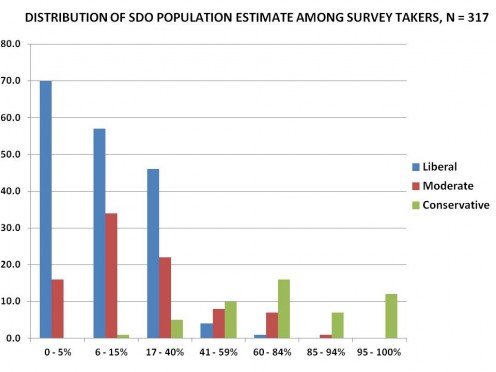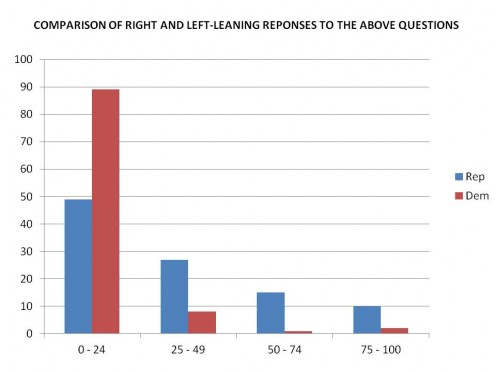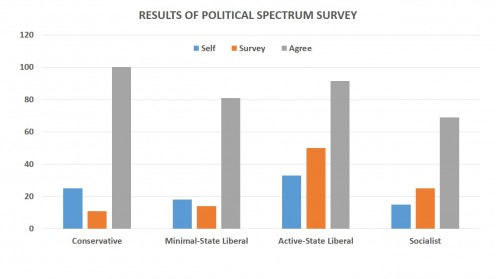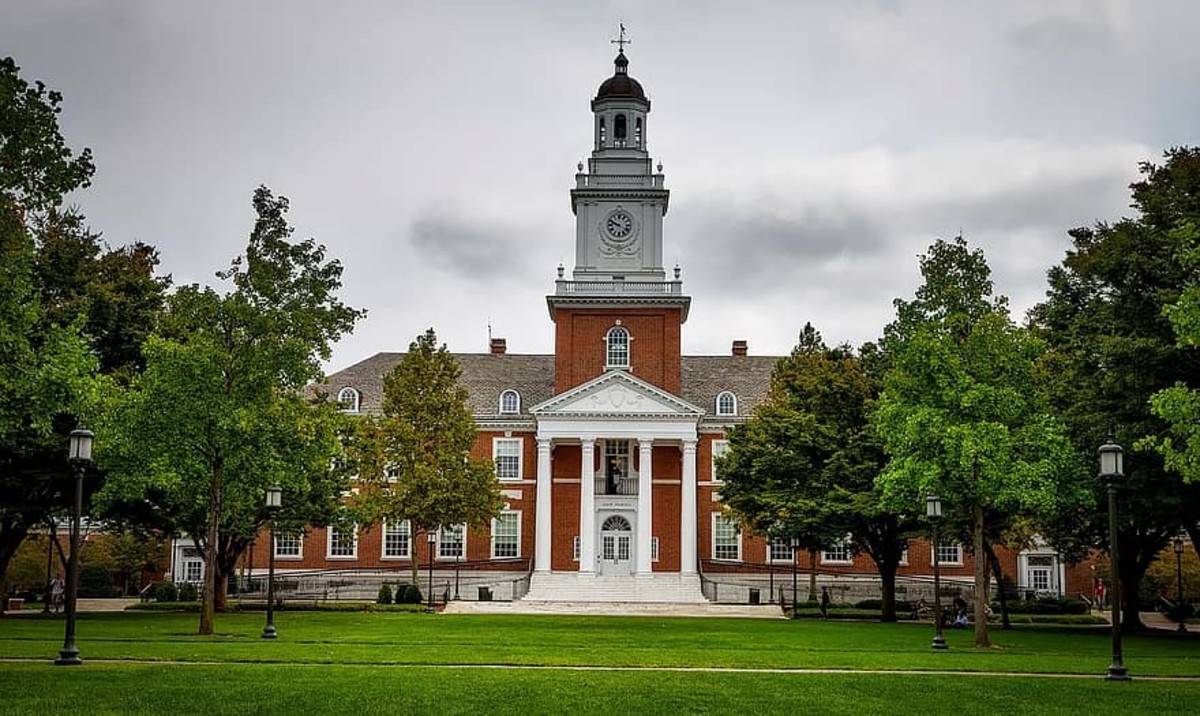America Divided: An Analysis of the Divergence Between the Political Right and Left
The Divided America
THROUGHOUT MOST OF AMERICAN POLITICAL HISTORY, there has been a canyon between those that make up the Right (Conservatives and Minimal State Liberals (MSL)) and the Left (Active State Liberals (ASL) and Socialists). There have been times throughout American political history the extreme element of one or both Parties controlled the House and/or Senate, but not both; in other words a split government much like we have today. And, like today, this situation puts the brakes any significant legislation. This is not how the signers of the Constitution meant it to work.
Fortunately, most of the time when Congress is split between Parties, each Party is represented by a broad mix of liberal, moderate, and conservative elements. For example, the period between 2007-8, 2011-present defines the former environment of conflict and stalemate; while the years 1960 and 1994 exemplifies an era of compromise. But the real question is, "what factors drive the sad state of affairs we are facing today?"
During the three years I have been writing hubs, several dealt with this issue. Those of you who follow me know that I am a Poll freak; I have polls of one sort or another in most of my hubs. For this hub, I am going to leverage off all of those hubs and polls and develop a somewhat systematic analysis of what drives to the two sides of America apart.
Specifically, many of these polls approach the differences between the Right and the Left from many different angles. By drawing the results of all these perspectives together to form a more holistic picture. My approach will be to present the details behind the polls in terms of human nature and where that puts people on the political spectrum and try to draw a common thread between which factors accomplish that result.
CONTROL
To be a Social Dominator is to be a person who wants to be in control in order to implement their political, social, and/or economic philosophies. This isn't the normal control to which many people aspire, but rather a type of charismatic, manipulative, no-holds-barred control to reach your goal. To reach their objective, Social Dominators utilize the characteristics of another set of people; people who are willing to follow authority figures without question..
When Social Dominator Oriented (SDO) people get into positions of power, say elected to Congress, they have no compunction to follow the normal rules of decorum and fair play to implement their policies; nor do they put State or National interest ahead of their own. As it turns out, this characteristic IS more frequently represented with the philosophies which drive people to one political party or another; although not universally so.
Below are the questions asked in my Social Dominator poll. Those people who tend toward SDO often agree with the following statements.
- Some groups of people are simply inferior to other groups.
- In getting what you want, it is sometimes necessary to use force against other groups.
- It’s OK if some groups have more of a chance in life than others.
- To get ahead in life, it is sometimes necessary to step on other groups.
- If certain groups stayed in their place, we would have fewer problems.
- Inferior groups should stay in their place.
- Sometimes other groups must be kept in their place.
Likewise, SDOs tend to disagree with these statements:
- It would be good if groups could be equal.
- Group equality should be our ideal.
- All groups should be given an equal chance in life.
- We should do what we can to equalize conditions for different groups.
- Increased social equality is beneficial to society.
- We should strive to make incomes as equal as possible.
- No group should dominate in society.
In a random world, you would expect just as many Left-leaners as Right-leaners to, on average, answer these questions the same way at roughly the same frequency. If that were the case, then when you plot the frequency of the 14 responses against Party affiliation, the two distributions should look somewhat the same; does that make sense.
Because Hubpage polls do not easily allow me to match Party affiliation with each question, I do the next best thing; I add the number of Agree choices from the first seven questions and add in the Disagree responses to the second set of seven questions; and then divide by, in this case, 14. Formal studies of SD orientation strongly suggests that the larger the result from that division, the more likely one is to exhibit SDO characteristics.
[If you are not interested in how this and other polling leads to valid results, you can skip the next four paragraphs.]
Now, I fully recognize my polling comes from a "non-random" population which makes drawing reasonable conclusions a bit more difficult. The lack of randomness is driven from the following:
- Before a reader answers the poll with their result, they first have to be the type to join Hubpages or to find the Hub via search engines,
- Then the reader has to be one that finds this subject interesting enough to read it most or all of the way through.
- Next, the reader needs to decide whether to take the survey or not
- Finally a decision is made on if they want to report the results.
That is far cry from randomly picking numbers from a phone book and calling someone. Fortunately, there is a way out.
Once a reader knows their score, I ask them to report that result in another poll and then ask them, in a third poll, to self-report their political bias. It is this trick that takes out much of the bias built into this effort from not having a truly random sample. It works because I end up looking a differences between results from each political bias; knowing that the sample, unrandom as it may be, still came from the same population of those who chose to take the survey in the first place. It is that feature, once I have a sufficient number of responses, that leads to valid results.
It does so in this manner. The validity rests in the fact that the same biases are at play within the Left-leaning group while another set of biases apply to the Right-leaning group; but, within each group the same forces lead them to answer the polls (actually I have three groups, but using two is easier to explain). That means the shape of each distribution may or may not be the same since I am comparing two groups answering the same set of questions. If the shapes are similar, then each group comes from the same sub-population, meaning there is no difference between the Right and Left, relative to these questions. If there is a noticeable difference in shape, then that is pretty clear evidence people who self-report they are Right-leaners believe differently about the same questions than the Left-leaners do; thereby solving my "unrandomness" problem.
[If you skipped the above paragraphs, you can start here again.]
Now look at Chart 1 below; the Blue distribution is from Left-leaning readers and the Green is from the other side. I also have a third choice, which I haven't mentioned yet, and that is for those who consider themselves moderates. It should be patently obvious that how one answers the SDO survey as a strong influence on which part of the political spectrum people choose to be.

Notice how those who consider themselves Liberal skew markedly to the low scores while those who self-identify as Conservatives have a distribution at the higher end of the scores. As would be expected, those who think of themselves as moderate fall in-between, although still weighted toward the lower scores.
Now go back to the 14 questions and consider how Liberals answered these questions and how on the Right answered the same questions in the opposite manner. Notice also that the question are pretty straight-forward, not much wriggle room when answering 'yes' or 'no' (actually it is a scale of relative agreement) as to whether you agree with the statement. It is perfectly clear that Liberals and Conservatives see the world through entirely different lenses. It should be just as obvious that when one or both political parties in Congress are composed primarily of the extremes of the spectrum, then nothing much will get done if both have significant power.
Notice also what is being stressed in these questions, one is the idea of Class and the other is the idea of equality. High scorers on the SDO survey are drawn to the the belief that for society to function best, it must be based on a hierarchy of Classes which, in turn, implies that "equality" must take a back seat for good order to be maintained. For low scorers, the reverse would be true.
In fact, if you consider some of the Ten Principles of Conservatism offered by Russell Kirk you find:
- # 3 - Conservatives believe in what may be called the principle of prescription - that is, of things established by immemorial usage, so that the mind of man runneth not to the contrary. It is perilous to weigh every passing issue on the basis of private judgment and private rationality. The individual is foolish, but the species is wise
- # 5 - Conservatives pay attention to the principle of variety - preservation of a healthy diversity in any civilization, there must survive orders and classes, differences in material condition, and many sorts of inequality. The only true forms of equality are equality at the Last Judgment and equality before a just court of law; all other attempts at leveling must lead, at best, to social stagnation.
Then consider the four elements of liberalism:
- Individualism – The “rule of man” is replaced by the “rule of law” where the protection of individual rights, in most instances, is more important than the rights of groups.
- Egalitarianism – Is legal and political equality, as well as, equal opportunity without artificial barriers, e.g., while all are able to start at the same place, not all finish together
- Universalism – The moral principles that define liberalism apply to all human beings
- Meliorism – The capacity of human beings to become better just as their social and political institutions can become better.
Is it any wonder why those who score low and high on the SDO scale have an extremely hard time understanding and working with each other?
Now let's move on to those who follow SDOs and other authority figures.
FOLLOWERS
RIGHT-WING AUTHORITARIAN (RWA) FOLLOWER IS a designation resulting from decades of research into why some people follow authoritarian figures more readily than others. The work initially began trying to explain Nazi Germany and the dynamics which allowed the Holocaust to occur.
The following set of questions are drawn from the work of Professor Altemeyer from the University of Manitoba. His survey has been used for decades to separate those who have a very strong tendency to follow authoritarian figures and those who won't.
Those who tend follow, with little questioning, the authority figure of their choice, will agree with the following statements:.
- Established authorities generally turn out to be right about things, radicals/protesters are loud mouths and ignorant.
- Women should have to promise to obey their husbands when they get married.
- We desperately need a mighty leader to do what needs to be done to destroy radical new ways/sinfulness that ruin us.
- It is better to trust the judgment of the authorities in government/religion than to listen to the noisy rabble-rousers
- To defeat the crisis ahead is to return to old values, elect tough leaders, and quiet troublemakers spreading bad ideas
- America will be destroyed one day if we don't smash the perversions eating away at our morals and traditional beliefs.
- The “old-fashioned ways” and the “old-fashioned values” still show the best way to live.
- What our country really needs is a strong, determined leader who will crush evil, and take us back to our true path.
- God’s laws on abortion/pornography/marriage must be followed before it is too late, and those who break them - Punished.
- Many radical/immoral people today are trying to ruin us for their own godless purposes; authorities should stop them now
- Honor the ways of our forefathers, follow authorities, and getting rid of “rotten apples” leads to National greatness
- America will work better if troublemakers would just shut up and accept their group’s traditional place in society.
Those more inclined to think independently will find these statements agreeable:.
- Gays and lesbians are just as healthy and moral as anybody else.
- Atheists/others who rebel against established religions are as good and virtuous as those attending church regularly
- There is absolutely nothing wrong with nudist resorts.
- Our country needs free thinkers who have the courage to defy traditional ways, even if this upsets many people.
- All should have their own lifestyle/religious beliefs/sexual preferences, even if it makes them different from others.
- You admire those who challenged the law/majority’s view by protesting for pro-choice and abolishing school prayer.
- Some of the best people are those who challenge our government/criticize religion/ignore the normal way things are done
- A “woman’s place” should be wherever she wants to be. The days when women are submissive to their husbands are over.
- There is no “ONE right way” to live life; everybody has to create their own way.
- Homosexuals and feminists should be praised for being brave enough to defy “traditional family values"
Those who score high on this survey are more likely than those who don't to, without much internal processing as to rightness or wrongness, follow the direction of those who they have identified as their authority figures. Authority figures come in all shapes and sizes; they could be priests, doctors, police, elected officials, and/or radio talk show hosts, to name a few.
As strange as it sounds, this willingness to follow is in spite of their personal beliefs; high RWAs will substitute, at least on the surface, their authority figures believe for their own, even it directly contradicts what they think is true. An analogy I use in my Hub is, "there are those who will believe and argue that 1 + 1 = 3, if that is what Rush Limbaugh says is true. High RWAs will continue to fight for acceptance of that fact until Rush says otherwise. To me, this is unbelievable, but nevertheless is true for I have witnessed such dedication to something that is empirically false.
As is true with SDOs, those who score high on the RWA scale tend (but not always) to fall among the Conservative ranks (I use conservative and liberal because they are more permanent labels than Democrat and Republican, which has switched sides a couple of times in the last 200 years). You can clearly see this preference in Chart 2 below.

NOTICE THAT 90% OF THE LIBERAL SIDE of the house scored in the lowest 25% while only 49% of the Conservative side did the same; that is significant. Further, 35% of Conservatives scored in the top 50%, compared to around 3% of Liberals. These are fully consistent with results of multiple studies conducted by Prof Altemeyer.
So, again reconsider the questions which were answered. The more in agreement people are with the first 12 questions, which focuses on the need for leadership, authority, and class differentials, and in disagreement with the last 10, which center on individualism, liberty, and egalitarianism, the more likely that person will exhibit strong RWA characteristics. Also notice that even among Liberals, there is a small set that score very high. This doesn't surprise me since when people are at the extremes of their respective political spectrums, they seem to lose their ability to think for themselves and let others think for them.
It should be evident that because RWA characteristics are much more strongly exhibited on the Right, that the Conservative SDO has a willing army of followers to carry their message. Liberals have no such luck. It also helps explain why, in today's political arena the leaders on the Right have a much easier time in keeping their troops in line; on the other hand, for the Liberals, it is like trying to herd cats.
Political Philosophies
IN ANOTHER HUB, I TRY TO MEASURE POLITICAL PHILOSOPHY DIRECTLY; titled "Do You Know Who You Really Are Socialist, Liberal, or Conservative". It is a work in progress as I am validating it while I am receiving results. Nevertheless, my hypothesis is that certain belief systems congregate in similar parts of the political spectrum. I go into this experiment with educated notions as which answers fall into which categories; Conservative, Minimal-state Liberal (MSL), Active-state Liberal (ASL), or Socialist. These are broad descriptors that are significantly differently from each other in most aspects but are common in a few. For example, MSL and ASLs have in common a belief that the law should be oriented toward the liberty of individuals; yet they differ significantly on how to achieve that end. Conservatives and Socialists share a common belief that laws should be geared toward classes of people, but disagree violently on which classes are more important.
The validation of this set of surveys is accomplished in two parts. First, the survey taker reports the results and second, they are asked if they agree with the results. A comparison is also made of the survey results with an initial survey of what category people believed they fell in.
For example, a Conservative or Socialist may respond positively to this question -
- Society is best served when the "rights" of certain classes of individuals trump an individuals right.
While MSLs, ASLs, and Socialists would answer negatively to this -
- The Supreme Court decision establishing the principle of "separate, but equal" was right for its time.
But only ASLs and Socialists would disapprove of this statement -
- The Civil Rights Acts were not needed, for the 13th, 14th, 15th, and 19th Amendments were enough to establish equality.
In this next case, Conservatives would tend to agree while ASLs and Socialists would not -
- In a capitalist society, labor should be treated as just another tool to produce a product
Here, Conservatives and MSLs would agree while ASLs and Socialists would not -
- Social "Darwinism", like biological Darwinism, is good because it separates the economically productive from others
And finally, only Socialists would agree with this statement -
- The inherent inequity in capitalism means ownership of primary industries should be left in the hands of the People
As you can see, what the questions try to do is to determine if the person taking the survey believes society is better served by addressing the concerns of certain classes or if it is more important to consider the rights of individuals over groups. For those who think classes are important, you need to figure out which classes those are and why. If it is the individual, the deciding factor is what role the government plays in ensuring individual liberty.
As with all things, it is more complex than that and there are several more pieces to the puzzle, but the above is the essential picture.
RESULTS OF POLITICAL SPECTRUM SURVEY

The blue bars represent what readers think their political leanings are; the orange bars are the results of the survey some of them took. The gray bars are the percentage of those who took the survey that agreed with their particular result. At this point in time, I wouldn't put too much stock in the difference between the blue and orange bars because there aren't enough results yet, only 46 as of this writing.
Now, compare the example questions in this section with the ones in the previous two sections. Notice the similarity of those questions that lead to higher SDO and RWA scores, and therefore a Right-leaning political orientation with a direct self-measure of political belief. Doesn't that imply they all validate each other?
THIS RETURNS US TO THE ORIGINAL QUESTION, why is it we are at such a political stalemate both in Congress and at the polls? You might be getting an inkling of an answer now. It is because those in political control of the Republican Party fall at the extreme end of the SDO and RWA surveys and while the Democratic Party and its leadership, since the Great Depression, has been more evenly divided over the political spectrum, it is nevertheless biased toward the other side. However, in recent years, , like since 1996, the political dynamics have pushed the center of the Democratic Party much further to the Left; not because their political attitude has changed but because the counterweight of those on the Right-side of Democratic political thought were voted out and replaced by Republicans, thereby leaving a much more left-leaning Democratic Congress.
Nevertheless, the make-up of the Democrats in Congress still cross the political spectrum from Right to Left. That same dynamic is not true for the Republican Party. While it is slowly breaking down, what moderate Republicans that are still left in the House and Senate have no political voice; unlike the Democrats, the far-Right is in complete control of the Republican Party today and until that changes, very little will happen in Congress, even if they lose the House; all that is needed is they prevent Democrats from having a super-majority in the Senate.
CONSIDER THE FOLLOWING THREE QUESTIONS taken from above:
- Some groups of people are simply inferior to other groups (SDO)
- Gays and lesbians are just as healthy and moral as anybody else. (RWA)
- Social "Darwinism", like biological Darwinism, is good because it separates the economically productive from others (Political Philosophy)
Aren't they somewhat similar in nature although asking whether you agree or disagree may be reversed. It seems to me each is talking about the inferiority of one group or type of individuals over another whether that arrangement ought to exist or not. And how do people answer these? Well:
- High scoring SDOs and RWAs would agree strongly with 1 and 3, but disagree just as strongly with question 2; Conservatives would do the same
- Those who are minimal-state liberals will agree strongly with number 3, but might be neutral on the other two as liberals tend to be egalitarian.
- Active-state liberals and socialists would definitely disagree with 1 and 3, and just as quickly agree with question 2.
And everyone of these people would sincerely believe they are right and can't understand at all how the other people can see it any differently. Each would say to the other ... "it only makes sense, don't you see?" To me, an active-state liberal, number 1 and 3 are an intolerable state of affairs, but to Governor George Wallace, a conservative, they are simple the way the world is and ought to be; and Rand Paul, a libertarian and minimal-state liberal, would violently disagree with 1, yet he would absolutely understand and agree with questions 2 and 3.
It isn't necessarily the lack of understanding the other's point of view that is problem, it is a person's unwillingness to admit there is another point of view that may be valid to some degree. When a belief is so strongly held, there is simply no room for compromise and that is where we are today. Those in control on the Right hold their beliefs so strongly, compromising means losing it all; for by compromising it totally invalidates their world view and says the other guy might be right.
And, because those with very strongly held political views, like the Tea Party and far-Right want it all, those who understand there are many sides to a coin, i.e. the Democrats, and would be willing to give up one thing of less important to them in order get something more important are forced to be just as obstinate and come off looking just as uncompromising; even though that isn't really the case.
ANOTHER WAY TO DEMONSTRATE THIS IS TO PUT IT TO A TEST. Below are three polls, one for those who think they lean to the Right, one for those who think they lean to the Left, and one for those who believe they live in the middle of the political spectrum. Beyond that, the question is the same.
The question isn't particularly controversial but it is nevertheless distinctive as one moves from Right to Left. This is taken from history, so let me set it up. In 1790, an extremely serious and acrimonious fight developed between Secretary of Treasury Alexander Hamilton, who wanted to create the First Bank of United States in order to accomplish a few of the same functions the Federal Reserve does today in order to help the newly minted America settle its war debts, and Representative James Madison, with support from Secretary of State Thomas Jefferson, who vehemently disagreed with this move as an unconstitutional overreach of the Federal government. President George Washington settled the argument by agreeing with Hamilton (ironically, Madison created the Second Bank of the United States in his second term to help end the recession he was in).
Part of the structure of the First Bank was a Sinking Fund Commission composed of Alexander Hamilton, Thomas Jefferson, Vice President John Adams, Attorney General Edmund Randolph, and Chief Justice John Jay. In 1792, America suffered a severe Panic resulting from a failed attempt to corner the U.S. debt securities market by a couple of very rich bankers. This resulted in a disastrous run on the major U.S. banks, especially the Bank of New York, bringing it and many others to the brink of failure. The Commission had a decision to make, just as the Federal Reserve did 217 years later; and that was whether to bail out the Bank of New York, which, if successful, would have saved other banks as well.
John Adams and Alexander Hamilton were for providing the Bank of New York $150,000 by having the Bank of United States by securities in open-market purchases; Jefferson and Randolph were opposed and Jay wasn't present. The tie was finally broken by one man changing sides before Justice Jay ever showed up. Let's assume, however, you are John Jay and you did show up; which side would you chose?
Your choices are:
- Buy $150,000 of securities from the Bank of New York, bailing it out, with a high likelihood of stabilizing the economy
- Not buy the securities and accept the reasonably good chance the Bank of New York and other large banks will fail sending the economy into a deep recession.
FOR THOSE LEANING TO THE RIGHT
If You Were John Jay In The Above Scenario Would You
FOR THOSE WHO LEAN TO THE LEFT
If You Were John Jay In The Above Scenario Would You
FOR THOSE WHO BELIEVE THEY LIVE IN THE MIDDLE
If You Were John Jay In The Above Scenario Would You
EXPECTATIONS
I expect you will find three distinct patterns of votes. Since I am a middle-of-the-road active-state liberal (there are several historically "conservative" issues I support and "liberal" issues I don't) and firmly believe the government must do what it can to keep the American economy from collapsing, I would vote with Adams and Alexander. It seems to me, that is the only rational course.
To you, the minimal-state liberal, that is balderdash! The government has no right to interfere with the free-market system, it will fix itself and the government will only make it worse. This is entirely rational to your way of thinking and mine is not, in fact mine is flat out dangerous. Consequently, you would side with Jefferson and Randolph.
Now, if you go back and take my SDO, RWA. and political spectrum surveys, chances are, if you voted with Jefferson and Randolph, your scores would probably not be at the low end of the SDO and RWA scales (you probably won't be at the high end either, few people are) and you will come out as a Conservative or Minimal-State Liberal on the political survey.
One the other hand, if you voted with Adams and Hamilton, chances are good you ended up at the low end of the SDO and RWA scales as well as being an Active-state Liberal or Socialist.
Let's see.
If You Voted With Thomas Jefferson and Edmund Randolph, Did You
If You Vote With John Adams and Alexander Hamilton, Did You
How About Your Personality, Can We Gain Insight From That?
THERE ARE MANY SURVEYS USED TO CLASSIFY a person's personality type; the one I prefer is the Meyers-Briggs Type Inventory (MBTI) which classifies people in four ways:
- Extrovert vs Introvert (E vs I: How people deal with the world)
- Sensor vs Intuitor (S vs N: How people receive information)
- Feeler vs Thinker (F vs T: How people process information)
- Judger vs Perceiver (J vs P: How people present themselves to the world)
You can get much more information from my hubs on Meyers-Briggs or any of the many other great hubs on the subject. Specifically, the information below is gathered from questions asked in an MBTI survey contained in Meyers-Briggs hub listed in Related Links below. Even though the number of responses in that hub are low at the moment, the results are nevertheless interesting from at least a curiosity standpoint. Keep in mind the sample size is very small:
- Extraverts tend to lean to the Left
- Introverts tend to be thoughtful or lean to the Right
- Sensor-Feelers tend to lean to the Right
- Intuitor-Feelers tend to be thoughtful or lean to the Left
- Sensor-Thinkers (don't like to take polls?)
- Intuitor-Thinkers tend to be thoughtful or lean to the Right
- Judgers tend to lean to the Right
- Perceivers tend to be Thoughtful or lean to the Left
I am an INTP. So, according to the above, I should be Thoughtful (Moderate) with a tendency to lean to the Right, which is close to correct unless we are talking about social issues.
Also know, that my F-T scores are like T-2, meaning I am barely on the Thinker side. In real life, when people are involved, then I am more of an INFP which makes me Thoughtful with a tendency to lean to the Left; which is true regarding social issues.
If you are interested, please go to my Meyers-Briggs (Personality) Type Inventory (MBTI) - An Experiment; Please Join hub and take the surveys.
© 2014 Scott Belford








